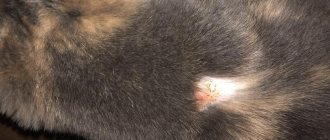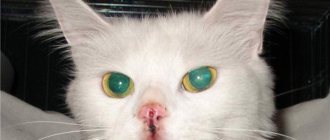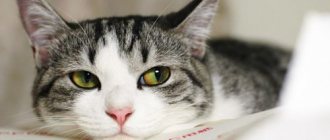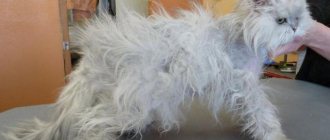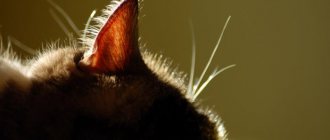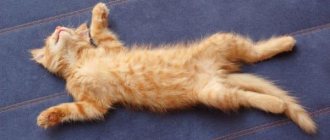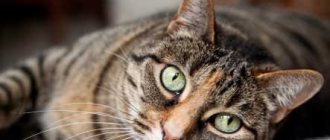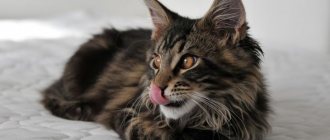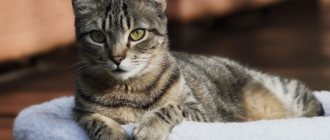Most often, a cat goes bald during the period of molting, which occurs seasonally. The process is natural, associated with the regular renewal of living tissues. But if hair loss becomes unnaturally abundant, suspicious symptoms appear, or the pet exhibits restless behavior, then veterinary attention is needed. The reasons why a cat has bald spots can be serious pathologies.
Why does a cat go bald: reasons
Baldness (alopecia) leads to the appearance of bare patches of skin on your pet's body.
If there is too much hair, bald spots appear, the animal behaves restlessly
The main reasons for the development of pathology:
- allergic reaction;
- damage by fleas, lice;
- the presence of a scabies parasite;
- otodectosis (ear mites);
- fungal or lichen infections (dermatomycosis, dermatophytosis);
- pyoderma;
- purulent formations on the skin;
- oily seborrhea;
- deficiency or excess of thyroid hormones;
- increased work of the adrenal glands;
- diabetes;
- genetic predisposition;
- stress;
- lack of vitamins;
- chronic diseases of internal organs.
Important! A common cause of alopecia is food allergies. It is not recommended to give pets food from the human table. Veterinarians advise buying specialized food that contains the necessary vitamins and minerals.
Healthy coat and lack thereof
The second name for baldness is alopecia. The pathology is manifested by abundant hair loss of the pet, the formation of bare areas - bald spots. In a healthy state, cat fur is soft, shiny, silky, and the hairs fit tightly together.
Cats have fur replacement year-round. During certain periods, the shedding of hairs increases and the density of the fur decreases significantly - this is molting. If the shedding cat’s health is normal, there are no pathological formations on the skin, the nose is moist and cold, and the appetite is good, then there is no reason to worry.
Lack of hair can be congenital and not associated with pathology. The peculiarity is detected from 4 months of age and cannot be treated.
By origin, alopecia is:
- symptomatic – associated with a specific pathology;
- idiopathic - an independent disease.
The source of baldness varies:
- diffuse – the fur comes out abundantly and evenly;
- localized – a certain area of the skin goes bald;
- partial – bald spots appear in different places.
When a cat tears at itchy skin with its claws, infection can enter the wounds and an inflammatory process will begin.
Common types of hair loss in cats
An analysis of the location of bald spots on the cat’s body and the condition of the skin helps to make a rough diagnosis.
| pathology | symptoms |
| dermatological diseases | uniform baldness of the trunk and limbs |
| hormonal imbalances | the cat's tail at the base, chest, nose, hips goes bald, the skin becomes inelastic |
| thyroid pathology | fur grows abundantly on the neck, chest, belly, and pelvic area |
| stress | the cat begins to itch intensely, the back, inner thighs, belly, limbs, and anus go bald |
| avitaminosis | the body begins to become covered with medium-sized naked spots of a round shape, usually merging, the skin in the lesions turns red |
| oncological pathologies | large bald spots cover the lower body, belly, limbs, complete loss of hair is possible |
| fungal infection | In bald areas, cracking and peeling of the skin is observed |
Symptoms of hair loss in cats
A healthy cat should have soft and silky fur.
Partial alopecia on the back of a cat
Severe hair loss requires treatment. Alopecia usually begins to manifest itself with the appearance of bald spots on a cat in one area of the body, and other areas of baldness gradually appear.
The skin at the site of loss may be rough and red with small wounds. If the area of a cat’s bald spot is painful or itchy, the animal reacts aggressively to touch.
Physiological causes of hair loss
Moderate hair loss is a natural process that does not always require treatment. The main reason for this phenomenon is annual molting, during which the old hair falls out and a new one grows in its place. It is noteworthy that cats lose much more fur than male cats.
Other causes of physiological hair loss:
- chafing collars, bandages or harnesses;
- bathing more often than once every 5 months;
- bathing with cheap human shampoos and detergents not intended for these purposes;
- stressful situation;
- age-related baldness in the area of the eyes, ears, paws, loss of mustache.
These causes do not pose any danger to the cat’s health and do not require treatment. As a rule, after a certain time, the fur grows back if the animal is not old.
Diagnosis of alopecia in different parts of the body
Only a doctor can determine why a cat is going bald. The basis of diagnosis includes medical history, visual examination, and microscopic examination of hair roots.
Be sure to read:
What to do if the cat sheds hair and the whole house is covered in fur all year round
The pet's blood is examined and a scraping is taken from the skin. If a tumor is suspected, an x-ray or ultrasound is performed.
The diagnosis is partially helped by the localization of bald spots on a cat:
- Symmetrical baldness of the abdomen, thighs, sides, and front legs is a characteristic symptom of a skin disease.
- Due to stress, cats tear out hairs in the anus , on the back, paws, stomach, and inner thighs. This happens especially often in the following breeds: Siamese, Abyssinian, Himalayan.
- Hormonal disorders are usually indicated by alopecia on the bridge of the nose , base of the tail, hips, and chest. The skin ceases to be elastic.
- In the case of a lack of thyroid hormones, pet hair is easily pulled out in the pelvic area , on the stomach, chest and neck.
- Cancerous formations provoke bald spots on the stomach, chest, and paws . Oncology can cause complete hair loss.
- Vitamin deficiency is characterized by the appearance of small, round bald patches, which can unite. The skin in places where there is no fur is bright pink.
- Fungal infections are characterized by the appearance of bald spots with scaly, cracked skin.
Scratching a pet's skin is dangerous due to infection and the development of an inflammatory process.
To make it easier for you to determine the cause of your pet's baldness, we have prepared a table. It contains all the main pathologies accompanied by hair loss in a cat:
Description of the problem
The structure of cat hair is not similar to human hair.
Unlike humans, most cats do not tend to go bald as they grow older. Despite periodic molting, they retain dense vegetation on their body even in old age. That is why the appearance of bald spots is always considered a pathology. The exception is hairless cat breeds. In these pets, the lack of hair on the body is a congenital feature.
Intense hair loss (alopecia) occurs in different areas of the body or can be symmetrical. The following areas are predominantly deprived of vegetation:
- stomach;
- back;
- lateral areas of the body;
- hips;
- hind legs;
- tail part.
Baldness in animals can be partial or complete. Most often, hair is lost during illness or as a result of reactions to negative stimuli. In some situations, a cat goes bald due to natural processes in the body.
In the presence of unfavorable factors, baldness can develop in both males and females. Most often, this pathology is observed in mature individuals and extremely rarely affects kittens.
How to treat baldness, what to do, how to help at home?
Therapy for the disease is aimed at eliminating the causes of alopecia:
- For allergies, contact with the allergen is eliminated, the use of anti-allergy drugs, immunostimulants, and diet are effective.
- For parasitic lesions, shampoo, ointment, and spray are prescribed.
- Pyoderma and abscesses are eliminated by excision of the affected skin, antibiotics and antiseptics are used to treat wounds.
- Stressful conditions are corrected by taking sedatives.
- Malfunctions of the thyroid gland are treated with hormonal medications; if a tumor develops, surgery is prescribed.
- Bacterial folliculitis is treated with antibiotics, usually amoxicillin. The pet is washed with medicated shampoo.
- For ringworm, the hair needs to be cut, Ketoconazole, Itraconazole, Griseofulvin are taken orally.
Important! Bald spots in cats caused by hereditary causes cannot be treated.
Diagnosis of the disease
The main task of an owner who notices that his cat is balding in the ears, back, abdomen and other parts of the body is to contact a veterinarian for a subsequent examination and diagnosis of the root cause that caused this problem.
To diagnose alopecia, the following measures may be necessary:
- analysis of medical history;
- visual examination of the skin, ear and mucous membranes of the cat;
- microbiological examination of wool bulbs;
- blood tests;
- analysis of epidermal scraping;
- hormone analysis;
- Ultrasound;
- X-ray examination.
All these methods together will help identify the presence of a disease that negatively affects the cat’s fur.
Baldness in cats, how to deal with shedding: advice from a veterinarian
Seasonal shedding is normal. This period is especially noticeable for owners of long-haired pets. Molting can last from 2 weeks to 3 months. Veterinarians advise washing and combing animals more often during this time.
Be sure to read:
A cat has a lump under the skin on its stomach: what is it, causes and treatment, what to do if it festers
Effective shampoos against hair loss:
- "Phytoelite" from "Veda";
- SynergyLabs Shed-X Cat;
- Perfect Coat 8 in 1.
It is useful to take vitamin complexes, preferably in liquid form.
Bald spots in cats caused by hereditary causes cannot be treated.
To remove hair from the stomach, it is recommended to give special medications:
- Pet Naturals of Vermont;
- Actipet;
- Vaseline oil, etc.
Ordinary grass can help get rid of lumps; in the summer, it is enough for the animal to go for a walk; in winter, the seeds can be purchased at pet stores and planted yourself.
If shedding is accompanied by specific signs, it is necessary to show the cat to a doctor.
Causes of baldness
If a cat is going bald, it is urgent to find out what the reason is. Alopecia is provoked by non-hazardous factors associated with physiological characteristics and pathological causes. The latter cannot be ignored; complications may cause the cat to die.
Seasonal molt
Periodic baldness in cats is normal. Long-haired breeds become especially noticeably bald. The duration of molting is from half a month to 3 months. During the period of baldness, the owner should bathe and comb the pet more often.
For bathing, use pet shampoos that strengthen the coat. Good ones, " Perfect Coat ". A shedding cat licks itself intensively and swallows the hairs that come out. Give your animal medications to remove hairballs from the digestive tract: Actipet , Pet Naturals of Vermont .
Conditions of detention
Both too little and too much grooming can damage your cat's fur. If the owner ignores the need to bathe and comb the pet, then the dirty coat becomes greasy and becomes tangled. In greasy, tangled skin, metabolism is disrupted, hairs weaken and fall out of the follicles. The cat, trying to comb itself, touches the tangles with its claws, tearing out the fur in shreds.
But excessive economic care is also harmful. With frequent bathing and the use of inappropriate products, the coat loses its oil protection, the hairs become thin and brittle. The optimal frequency of procedures is once every six months; when shedding, once a week. Do not use human hygiene products, buy pet shampoos.
Do not let your pet lie for a long time on a running radiator or on a windowsill in direct sun. Otherwise, the hair follicles will become inflamed and the hair will begin to fall out.
If there are several cats living in the house, make sure that they do not fight. If you walk your pet on a leash, check how tight the harness is. Due to the friction of the harness, the neck and armpits become bald. Inflammation and baldness of the neck can be a consequence of using a flea collar, the chemical composition of which is perceived by the body as an allergen.
Stress
Cats are vulnerable and perceive the slightest negativity painfully. Any circumstance can be a stress factor: from cruel treatment by the owner to the inability to catch a bird through a window glass. Emotional shocks have a negative impact on the condition of the coat. With prolonged exposure to stress, the animal begins to go bald in patches, forming an extensive bald spot.
Sometimes severe and prolonged stress provokes the development of a mental disorder called displaced behavior. The animal cannot influence the situation, get rid of stress, so it transfers the effect onto itself: it goes bald, nervously licks and itches, gnaws off its skin, tears out its fur in shreds. If a cat scratches its body excessively, ulcers and bruises form.
Stress factors that cause cat hair loss:
- isolation within four walls, lack of communication;
- lack of physical activity;
- long separation from the owner;
- lack of entertainment;
- jealousy of a new pet;
- moving to another home, renovation;
- bullying from family members.
What should the owner do if the cat is going bald? Eliminate the negative factor. Give your pet enough attention: walk it, play active games at home, pet it, buy toys. If there are several pets in the house, take equal care of each one. Do not get a cat if you are often away or go on business trips.
You should not buy a cat for a family with a baby. Firstly, the pet will become jealous of the owner. Secondly, a baby can inadvertently injure an animal, break its tail, or strangle it. Explain to an older child that a kitten is not a toy and should not be mocked.
When moving or renovating, give your cat a sedative in consultation with your veterinarian.
Hormonal
With dysfunction of the endocrine organ - thyroid, pancreas - metabolism is disrupted. In most cases, the culprit of endocrine disorders and baldness is the owner who gives the pet hormonal drugs to suppress sexual desire without the consent of the veterinarian.
With endocrine pathologies, different parts of the body itch intensely. The cat itches constantly and intensely, and goes bald. After castration and with pathologies of the ovaries in females and testes in males, the skin under the tail becomes bald.
What hormonal pathologies in cats are accompanied by baldness:
- Hyperthyroidism is an increased function of the thyroid gland. The cat has seborrhea, the fur comes out in clumps from a light touch.
- Cushing's disease - increased synthesis of corticosteroids.
- Diabetes is a disorder of the pancreas. In addition to baldness, the cat has thirst, frequent urination, and an acetone odor from the mouth.
Treatment involves taking hormonal medications, which should be chosen by a veterinarian.
Estrus
For a cat, estrus is a stressful period. Empty ovulation takes away physical strength and depletes the immune system. The fur comes out evenly and the skin temperature rises.
If you do not plan to breed the breed, sterilize the cat. This will save the animal from suffering and baldness. Empty estrus is not only a painful process, but also dangerous: there is a high probability of the appearance of malignant tumors of the gonads.
Pregnancy
The body of a pregnant cat works hard, wasting energy not only on itself, but also on the embryos developing in the womb. Intensive waste of the body's resources inevitably affects the condition of the coat: the hairs become thinner and come out in clumps.
Baldness continues after childbirth, because a significant part of the nutrients leaves the body into milk. The belly of a cat that has given birth goes bald most intensively, which is caused by hormonal changes. The mother's hairless sides and belly help newborn kittens to stay warm, and finding nipples in the absence of hair becomes easier.
A nursing cat needs an increased supply of vitamins and nutrients, so buy high-quality food designed specifically for postpartum animals. When feeding naturally, enrich the diet with vitamin and mineral complexes in consultation with your veterinarian.
Poor nutrition
A common reason why a cat goes bald is food allergies. The owner does not care about the pet’s healthy diet, buys cheap food, gives food that is unsuitable for the cat’s body or is expired, as a result, allergens and toxic substances enter the pet’s body.
Most often, the allergen is cheap, low-quality store-bought food. The quality of nutrition determines not only the health of the coat, but also the general well-being of the cat. The components included in cheap feeds provoke baldness and internal pathologies. Therefore, when purchasing cat food, carefully read the ingredients list.
If the ingredient list simply says “meat,” then the manufacturer hides the ingredients. High-quality food indicates what type of meat was used and in what volume.
You should absolutely not buy food for your cat that contains:
- preservatives;
- synthetic dyes (E127 is especially dangerous - a provocateur of cancer);
- sugar, its derivatives;
- cellulose fibers;
- propylene glycol;
- antioxidant E310 (causes asthmatic attacks);
- antioxidant E324 (strong carcinogen);
- antioxidants BHA and BHT (cause malignant tumors in animals).
To prevent your cat from going bald due to allergies and to remain healthy, do not skimp on nutrition, buy high-quality food from trusted manufacturers that contain a full range of essential vitamins, minerals, and nutrients. Best brands:
- Royal Canin;
- Acana;
- Orijen;
- Brit;
- Hill's;
- Almo Nature;
- Golden Eagle;
- Innova;
- Farmina.
Natural food can also be an allergen for cats. It could be chicken, pork, fish, milk. The symptoms are pronounced: hair comes out evenly on the stomach and paws, the cat is tormented by unbearable itching, the skin is red and covered with a rash. Often, due to allergies, a cat's ears become bald due to inflammation. The pet scratches its ears until blood comes out of the itchy wounds.
Having identified the allergen, exclude the harmful product from the cat's menu. Do not give your pet food from the human table.
Avitaminosis
When the owner does not provide a balanced diet, the pet begins to lose weight, go bald, becomes lethargic, apathetic, anemic, the fur becomes dull - this is the beginning of vitamin deficiency. With a deficiency of vitamins A, C, group B, bare spots appear on the back, limbs and head, gradually merge, and the skin turns red.
It’s time to immediately start normalizing your diet, otherwise your metabolism will worsen and the functioning of your internal organs will be disrupted. Buy a cat vitamin complex for coat health in liquid form. Remember that an excess of vitamins is just as harmful as a deficiency: it provokes toxicosis and impaired liver function. Do not give your cat drugs in high doses, coordinate the appointment with your veterinarian.
Allergy
Allergic dermatitis is a reaction to substances that come into contact with the skin and respiratory tract: medications, household chemicals, pollen, fragrances, flea or tick medications. An allergic reaction is manifested by baldness, itching, redness of the skin, and a pustular rash. The cat constantly scratches the itchy areas, causing fur to come out.
How to treat dermatitis - antihistamines, immunostimulants. The main condition for recovery is the elimination of the allergen.
Adenitis
Disruption of the sebaceous glands is manifested by baldness, inflammation of the skin, and the formation of scales, first dry, then wet and sticky. The cat's ears and head are going bald. Spots without fur covering the ear, back of the head, eyebrow, rounded, exude a stench. In advanced cases, balding areas appear on the tail and along the spine. The spots itch, the animal constantly licks and itches.
Fleas
A cat affected by fleas becomes nervous, goes bald, sleeps poorly, scratches, and licks the bite site. The saliva of parasites is an allergen and causes inflammation, bald spots, and dandruff. Not only stray cats are affected by fleas; a pet can pick up the parasite from an owner who comes in from the street.
Flea-infested cats are treated with special pet shampoos and sprays.
Mite
Parasitic mites cause the following pathologies:
- Demodicosis is a skin lesion with itchy patches of baldness.
- Cheyletiellosis is an infection of the skin with intense itching, peeling, and hair loss.
- Otodecosis is infection of the ears by mites. The affected ear itches, the cat scratches his temple. It can tear your ears until they bleed, and a bald spot will appear on your temples.
- Scabies is a lesion of the upper layer of skin with baldness and unbearable itching. The tick prefers areas with thin skin: above the eyebrows, between the toes, nose, jaw.
Lichen
Cats with weak immune systems are susceptible to fungal disease. The skin on the face and above the eyes is the first to go bald. Bald areas turn red, peel, itch, and expand. Purulent foci appear.
Ringworm is a contagious disease; treatment should not be delayed. Medicines are prescribed by a veterinarian; incorrect independent actions can make baldness chronic.
The drugs Itraconazole and Ketoconazole are usually used for treatment.
lice eaters
Parasites damage the fur. The fur breaks off and comes out. Baldness is aggravated by constant itching, due to which the cat begins to intensively scratch its body.
Oncology
The body fighting cancer cells does not provide the hair follicles with sufficient nutrition. Therefore, the cat's fur grows intensely.
Ignoring cancer is dangerous and there is a high probability of the animal’s death. The owner must monitor the well-being of the pet. If the cat has suddenly lost weight, is not eating, is going bald, the lymph nodes are swollen, ulcers and purulent wounds appear on the outside, contact your veterinarian immediately.
The tumor is removed by a surgeon, followed by chemotherapy. Don't worry if your cat is going bald on the belly, spine and hind legs: this is a reaction to the medications. After chemotherapy, the fur will recover.
Infection
Infectious diseases deplete the immune system, so a recovering cat may go bald. Usually the cat's face and stomach become bald.
Baldness can be caused by pyoderma, a purulent inflammation of the skin, and folliculitis, a bacterial inflammation of the hair follicles. Antibiotics are used for treatment.
Age
When 5-month-old kittens go bald, we are talking about juvenile molting. Within 3 months, a kitten's baby fur is replaced by adult fur.
Bald spots on the fur are a sign of the onset of old age. In older cats, the stomach does not properly digest food, and the body receives little nutrition. An older cat may frequently lick the part of the body where the joints are affected. Usually this is the leg. In areas that are licked, the fur wears off.
Disorders of internal organs
Alopecia in cats is provoked by various diseases of the digestive tract, accompanied by nausea, defecation disorders, loss of appetite, weight loss:
- pancreatitis - inflammation of the pancreas;
- cirrhosis – destruction of liver cells;
- gastritis , colitis, other disorders of the stomach and intestines.
When a cat has digestive diseases, the first thing to go bald is the tail. The listed pathologies often arise if the owner feeds the cat spoiled food, allows obesity, or does not give vitamins.
Preventing hair loss in cats
To protect your pet from the unpleasant symptoms of hair loss, owners need to follow several rules:
- Provide your cat with a balanced diet.
- Avoid factors that provoke stress.
- Vaccinate against infectious diseases on time.
- Avoid contact between a healthy animal and a sick one.
- Treat wool promptly when parasites appear.
- Carry out preventive examinations regularly.
Treatment options
Having determined the diagnosis, the specialist prescribes treatment. It is aimed at restoring the coat, as well as neutralizing the cause of baldness in the cat.
Treatment methods:
- If the problem is related to an allergic reaction, the animal must be completely protected from the allergen. After this, medications are prescribed to improve immunity. If the allergy is caused by food, then it is necessary to put the cat on a diet.
- Skin lesions from mites and lice must be treated with special antiparasitic drugs. The diet includes vitamins and nutritional supplements to strengthen the immune system.
- If a bald spot on a cat’s body appears due to an infectious disease, the doctor will prescribe a course of antibiotic therapy. As a rule, Amoxicillin is used for this.
- Baldness caused by stress in an animal is treated with special sedatives.
- Alopecia caused by demodicosis is treated by bathing with sulfur-selenium shampoo (1%).
- If the veterinarian has diagnosed ringworm, then treatment is carried out with the following drugs: Ketoconazole, Itraconazole, Griseofulfin, and so on. In this case, it is recommended to use immunosupportive agents and medications to improve metabolism. It is important to remember that ringworm is transmitted to humans.
- For endocrine disorders, hormonal drugs are prescribed.
- Skin abscesses are treated with local or systemic antibiotics, as well as antiseptics.
Use medications prescribed by your veterinarian. Self-medication can harm the animal, especially if you use the wrong medicine or do not maintain the permissible dosage.
The cat's stomach, hind legs, and withers are bald: what to do, how to treat it?
If a pet has health problems, it is always a worry for the owners. After all, you want to help the animal as quickly as possible. So, the cat has a bald stomach, hind legs, and withers - what to do, how to treat it? First you need to determine the cause of the disease and eliminate it:
- Check your cat's diet . Choose hypoallergenic quality food. With the right diet, you don’t even have to look for additional sources of vitamins.
- Improve the animal's living conditions . Move his bed away from the radiator and humidify the air.
- Use parasite killers . For example, Spot-on or IN-AP .
- If you are sure that the cause is an allergic reaction , tell your veterinarian.
- If the cause is stress , use sedatives, for example, Stop-Stress or Vetspokoin .
There are special vitamins for cats against hair loss. For example, brewer's yeast helps a lot. But you should not self-medicate. Be sure to visit a veterinarian. Only he will be able to establish an accurate diagnosis and choose a method of treating the animal.
Disease prevention
Preventive measures aimed at preventing alopecia in cats are as follows:
- regular veterinary examinations;
- timely vaccination of your pet;
- compliance with hygiene rules for cats;
- proper nutrition of animals.
The appearance of bald patches behind the ears, above the eyes and on other parts of the cat’s body is a fairly common phenomenon caused by various etiologies. There are several causes of alopecia (baldness) in pets: mainly endocrine disruptions, food allergies and parasites. Depending on why the cat has receding hairline, the veterinarian will prescribe treatment for the pet.
Some tips for proper pet care
To prevent the occurrence of pathological diseases of the cat family, it is important to follow a number of simple rules:
- feed correctly. It is not recommended to give pets food from the common table;
- eliminate or minimize stress;
- avoid contact with infected animals;
- maintain all appropriate vaccinations;
- monitor the fur, ears, eyes and general condition of the animal;
- Treat the animal for parasites in a timely manner.
By regularly examining your pet and carrying out all the necessary procedures, you will maintain his health for many years.
